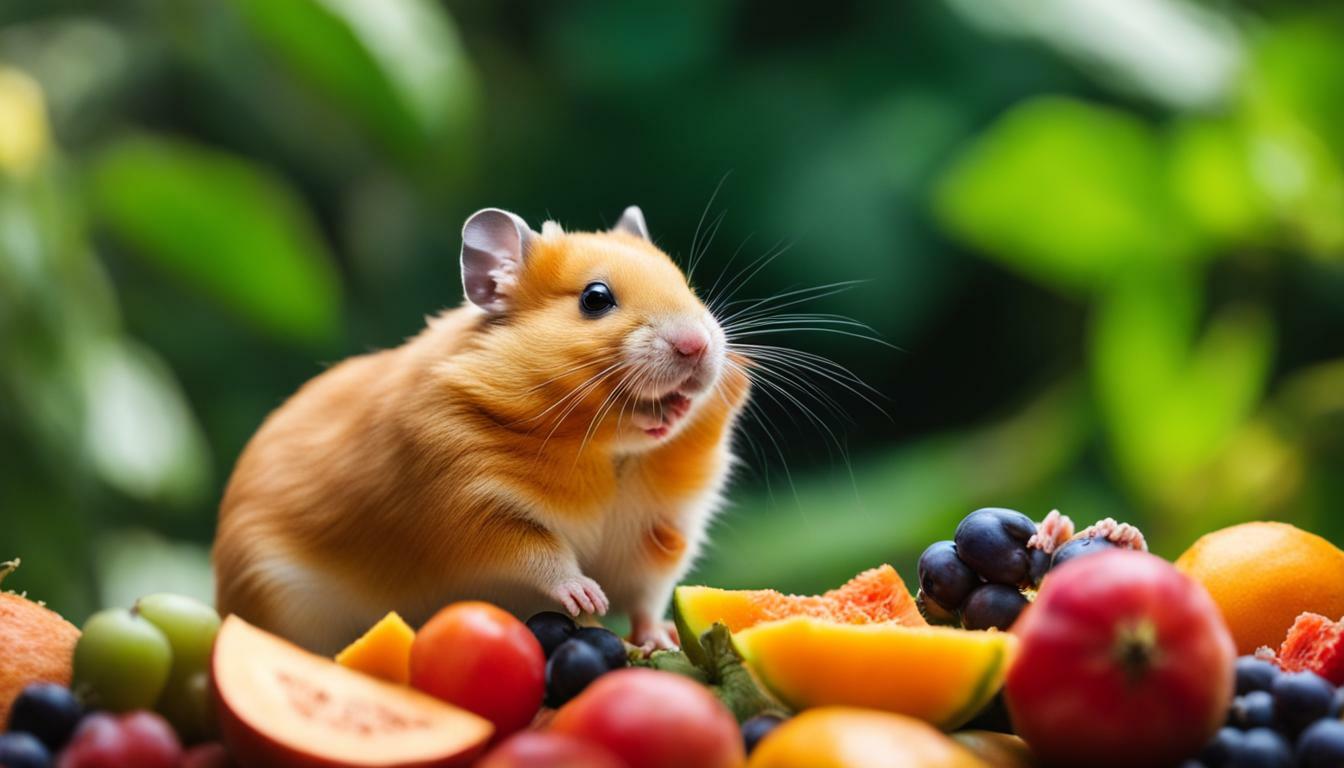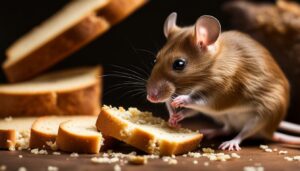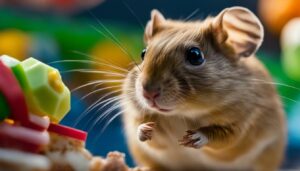If you’re wondering, “Can hamsters eat papaya?” you’ve come to the right place for answers. Many hamster owners are curious about whether this tropical fruit is safe for their furry friends. In this article, we’ll explore the topic and provide you with all the information you need to make an informed decision about feeding papaya to your hamster.
Key Takeaways:
- Papaya can be fed to certain species of hamsters, such as Syrian and Roborovski hamsters, in small amounts as part of a balanced diet.
- Smaller species like Winter White Dwarves, Russian Campbell Dwarves, and Chinese hamsters should not be fed papaya due to its high sugar content, which can lead to obesity and digestive issues.
- Never feed hamsters the skin or seeds of papaya, as they can pose a choking hazard.
- Papaya is rich in antioxidants, fiber, vitamins, and minerals, which can provide various health benefits for hamsters, including supporting their immune system, bone health, eye health, and fur growth.
- A healthy hamster diet consists primarily of commercially available hamster pellets, supplemented with low-sugar fresh fruits and vegetables, dried mealworms, and occasional protein snacks like boiled eggs and nuts.
Papaya and Hamster Diet
Papaya can be a part of a hamster’s diet when fed in appropriate amounts alongside other nutritious foods. It is important to note that certain species of hamsters, such as Syrian and Roborovski hamsters, can handle the higher sugar content of papaya better than smaller species like Winter White Dwarves, Russian Campbell Dwarves, and Chinese hamsters. For these smaller hamsters, it is best to avoid feeding them papaya due to the potential health risks it poses, including obesity and digestive issues.
When incorporating papaya into a hamster’s diet, it is crucial to remove the skin and seeds before feeding it to them. The skin and seeds can pose a choking hazard and should be avoided. However, the flesh of the papaya itself is rich in antioxidants, fiber, vitamins, and minerals that can benefit a hamster’s immune system, bone health, eye health, and fur growth.
It is always important to ensure a hamster’s diet is well-balanced. The primary component of their diet should be commercially available hamster pellets, which are formulated to provide the necessary nutrients. These pellets should be supplemented with low-sugar fresh fruits and vegetables, such as carrots, spinach, and apples, as well as occasional protein snacks like boiled eggs and nuts. Dried mealworms can also be included as a source of protein. As with any pet, hamsters should have access to clean and fresh water at all times, preferably provided through a water bottle with a metal spout.
Table: Hamster Diet Recommendations
| Food | Frequency |
|---|---|
| Commercially available hamster pellets | Daily |
| Low-sugar fresh fruits and vegetables | Several times a week |
| Protein snacks (boiled eggs, nuts) | Occasional treats |
| Dried mealworms | Occasional treats |
Remember to consult with a veterinarian or a qualified pet nutritionist to ensure your hamster’s diet meets their specific needs. By providing a well-balanced diet that includes appropriate amounts of papaya and other nutritious foods, you can help keep your hamster healthy and happy.
Papaya for Certain Hamster Species
While papaya can be enjoyed as a treat by certain hamster species, it’s important to consider the size and sugar tolerance of your pet. Larger hamsters, such as Syrians and Roborovskis, can handle the higher sugar content of papaya in small amounts. However, smaller species like Winter White Dwarves, Russian Campbell Dwarves, and Chinese hamsters should not be fed papaya due to the high sugar content, which can lead to obesity and digestive issues.
When offering papaya to your hamster, it is crucial to ensure that the skin and seeds are removed. These parts can pose a choking hazard and are not suitable for hamster consumption. By providing only the flesh of the papaya, you can minimize any potential risks associated with feeding this fruit to your furry friend.
Papaya is a nutritious fruit that offers several health benefits for hamsters. It is rich in antioxidants, fiber, vitamins, and minerals, which can support their immune system, promote bone health, enhance eye health, and contribute to healthy fur growth. However, due to the high sugar content, it’s essential to offer papaya as an occasional treat and in moderation, especially for smaller hamster species.
To ensure a well-rounded diet for your hamster, their primary food source should be commercially available hamster pellets, which provide the necessary nutrients for their overall health. Alongside these pellets, you can supplement their diet with low-sugar fresh fruits and vegetables, dried mealworms, and occasional protein snacks like boiled eggs and nuts. Don’t forget to provide your hamster with constant access to clean and fresh water, preferably through a bottle with a metal spout.
| Pros of Feeding Papaya | Cons of Feeding Papaya |
|---|---|
|
|
Sugar Content and Health Risks
Due to its higher sugar content, papaya should be approached with caution when considering the health of your hamster. While larger hamster species like Syrians and Roborovskis can handle the occasional consumption of papaya, it is not recommended for smaller species such as Winter White Dwarves, Russian Campbell Dwarves, and Chinese hamsters.
Feeding papaya to these smaller hamsters can lead to potential health issues, including obesity and digestive problems. It is important to remember that moderation is key when introducing any new food to your hamster’s diet.
When offering papaya to your hamster, always remove the skin and seeds as they can pose a choking hazard. By providing your hamster with seedless and skinless papaya, you reduce the risk of any potential harm.
| Species | Suitability for Papaya |
|---|---|
| Syrian Hamsters | Can tolerate papaya in small amounts |
| Roborovski Hamsters | Can tolerate papaya in small amounts |
| Winter White Dwarves | Should avoid papaya due to high sugar content |
| Russian Campbell Dwarves | Should avoid papaya due to high sugar content |
| Chinese Hamsters | Should avoid papaya due to high sugar content |
Papaya does offer some nutritional benefits for hamsters, including antioxidants, fiber, vitamins, and minerals that support immune system function, bone health, eye health, and fur growth. However, it is important to consider the potential health risks associated with the high sugar content when deciding whether to include papaya in your hamster’s diet.
A balanced diet for hamsters primarily consists of commercially available hamster pellets. These should be supplemented with low-sugar fresh fruits and vegetables, dried mealworms, and occasional protein snacks such as boiled eggs and nuts. Always ensure your hamster has access to clean and fresh water provided through a water bottle with a metal spout.
Nutritional Benefits of Papaya
Incorporating papaya into your hamster’s diet can provide them with essential nutrients that contribute to their overall well-being. Papaya is rich in antioxidants, fiber, vitamins, and minerals, making it a beneficial addition to their meals. These nutrients support various aspects of your hamster’s health, including their immune system, bone health, eye health, and fur growth.
Antioxidants found in papaya help protect your hamster’s cells from damage caused by harmful molecules called free radicals. This can boost their immune system and help them fight off illnesses more effectively. The fiber content in papaya promotes healthy digestion and can prevent constipation in your furry friend.
Papaya contains several vitamins that are important for your hamster’s well-being. Vitamin C, for example, is crucial for their immune system and can aid in wound healing. Vitamin A supports their eye health and can help prevent vision problems. Additionally, papaya is a good source of minerals such as potassium, which is essential for proper nerve and muscle function, and magnesium, which contributes to bone health.
| Nutrients | Benefits |
|---|---|
| Antioxidants | Boosts immune system |
| Fiber | Promotes healthy digestion |
| Vitamin C | Aids immune system and wound healing |
| Vitamin A | Supports eye health |
| Potassium | Essential for nerve and muscle function |
| Magnesium | Contributes to bone health |
While papaya offers these nutritional benefits, it’s important to remember that the high sugar content can be a health risk for certain species of hamsters. Larger hamsters, such as Syrians and Roborovskis, can handle the higher sugar content in moderation. However, smaller species like Winter White Dwarves, Russian Campbell Dwarves, and Chinese hamsters should avoid papaya due to their sugar sensitivity, as it can lead to obesity and digestive issues.
A well-balanced diet for your hamster primarily consists of commercially available hamster pellets, which provide essential nutrients. These pellets should be supplemented with low-sugar fresh fruits and vegetables, dried mealworms, and occasional protein snacks like boiled eggs and nuts. It is important to ensure that your hamster always has access to clean and fresh water in a bottle with a metal spout to stay hydrated.
Hazards of Papaya Seeds and Skin
When offering papaya to your hamster, always ensure that the seeds and skin are removed to prevent any potential risks. The seeds of papaya can pose a choking hazard, especially for small hamster species like Winter White Dwarves, Russian Campbell Dwarves, and Chinese hamsters. These tiny seeds can easily get lodged in their throats, causing discomfort and potentially leading to respiratory problems. Additionally, the skin of papaya is tough and difficult for hamsters to chew and digest, which can result in gastrointestinal distress.
To ensure the safety of your hamster, carefully peel the papaya and remove the seeds before offering it as a treat. Cut the papaya into small, bite-sized pieces that are easier for your hamster to handle. By taking these precautions, you can minimize the risk of choking or digestive issues and provide a safe and enjoyable experience for your furry friend.
Table: Safe Treats for Hamsters
| Treat | Suitable for Hamsters |
|---|---|
| Papaya (without seeds and skin) | Yes, for larger hamster species (e.g., Syrians and Roborovskis) |
| Apples (seedless and skinless) | Yes, in moderation for all hamster species |
| Carrots (small pieces) | Yes, in moderation for all hamster species |
| Cucumber (seedless) | Yes, in moderation for all hamster species |
| Sunflower seeds | Yes, as an occasional treat for all hamster species |
Remember that treats should only make up a small portion of your hamster’s overall diet. Stick to commercially available hamster pellets as the primary source of nutrition and offer treats sparingly. A balanced diet is crucial for your hamster’s health and well-being, and incorporating a variety of safe treats can add enjoyment to their daily routine.
Ideal Hamster Diet
To maintain a healthy hamster, it’s important to prioritize a balanced diet consisting of commercial pellets and a variety of other nutritious foods. A hamster’s diet should be rich in essential nutrients to support their overall well-being and vitality. Commercially available hamster pellets should make up the bulk of their daily food intake, as these pellets contain a mix of grains, seeds, and other ingredients specifically formulated for hamsters’ nutritional needs.
In addition to pellets, fresh fruits and vegetables can be offered as supplements to provide added vitamins and minerals. However, it’s crucial to choose low-sugar options to avoid any adverse health effects. A moderate amount of papaya can be included in a hamster’s diet, but only for certain species. Larger hamsters like Syrian and Roborovski hamsters can tolerate the higher sugar content of papaya better than smaller species such as Winter White Dwarves, Russian Campbell Dwarves, and Chinese hamsters.
| Foods to Include | Foods to Avoid |
|---|---|
|
|
Remember to provide your hamster with clean and fresh water at all times. A water bottle with a metal spout is the ideal method of water delivery, as it prevents spills and contamination. By following these dietary guidelines, you can ensure that your hamster receives the necessary nutrients for optimal health and well-being.
Recommended Treats for Hamsters
As a treat option for your hamster, papaya can offer a refreshing and enjoyable addition to their diet. Papaya is packed with essential nutrients, including antioxidants, fiber, vitamins, and minerals, making it a healthy choice for larger hamster species like Syrian and Roborovski hamsters.
However, it’s important to remember that smaller hamster species such as Winter White Dwarves, Russian Campbell Dwarves, and Chinese hamsters should not be fed papaya due to its high sugar content. These smaller hamsters are more prone to obesity and digestive issues, so it’s best to avoid feeding them papaya altogether.
When offering papaya to your hamster, it’s crucial to remove the skin and seeds, as they can pose a choking hazard. Cut the papaya into small, bite-sized pieces, ensuring that it is fresh and ripe. Moderation is key, so only offer papaya as an occasional treat, alongside a well-balanced diet.
| Recommended Treats for Hamsters | Suitable for | Not Suitable for |
|---|---|---|
| Papaya | Syrian and Roborovski hamsters | Winter White Dwarves, Russian Campbell Dwarves, and Chinese hamsters |
| Apples | All hamster species (in small quantities) | None |
| Carrots | All hamster species (in moderation) | None |
Remember that treats should only make up a small portion of your hamster’s overall diet. Their primary source of nutrition should come from commercially available hamster pellets, supplemented with fresh fruits and vegetables low in sugar.
Additionally, ensure your hamster has access to clean and fresh water at all times. Use a water bottle with a metal spout to prevent spills and contamination. By offering a well-rounded diet and occasional papaya treats, you can keep your hamster healthy, happy, and satisfied.
Water and Hydration
Alongside their diet, ensuring your hamster has access to clean and fresh water is crucial for their overall health and hydration. Hamsters have a high metabolic rate and can easily become dehydrated if they do not have enough water available. A water bottle with a metal spout is the preferred method of water delivery, as it allows hamsters to drink without spilling or contaminating the water. Make sure to clean the water bottle regularly to prevent any bacterial growth.
| Signs of Dehydration | Prevention and Maintenance |
|---|---|
|
|
“Water is essential for the proper functioning of your hamster’s body. Without enough water, they can experience dehydration, which can lead to serious health issues. Make sure to provide your furry friend with clean and fresh water at all times, and regularly check on their water bottle to ensure it’s working properly. Remember, a hydrated hamster is a happy and healthy hamster!”
Remember that individual hamsters may have varying water intake needs, depending on factors such as their size, activity level, and environment. Some hamsters may drink more water than others, while some may prefer to hydrate from fruits and vegetables as well. Observing your hamster’s behavior and monitoring their water consumption will help you determine if they are adequately hydrated.
| Water Sources for Hydration | Water Frequency and Amount |
|---|---|
|
|
Considerations for Different Hamster Species
It’s essential to consider the species of your hamster when deciding whether to include papaya in their diet. While larger hamsters like Syrians and Roborovskis can handle the higher sugar content of papaya in small amounts, smaller species like Winter White Dwarves, Russian Campbell Dwarves, and Chinese hamsters should not be fed papaya due to the potential health risks it poses.
These smaller hamster species are more prone to obesity and digestive issues, so it’s best to avoid feeding them papaya altogether. The high sugar content can lead to weight gain and imbalance their sensitive digestive systems. To ensure their overall health and well-being, it is recommended to focus on a diet primarily consisting of commercially available hamster pellets.
| Hamster Species | Feeding Recommendation |
|---|---|
| Syrians and Roborovskis | Small amounts of papaya can be included in their diet |
| Winter White Dwarves, Russian Campbell Dwarves, and Chinese hamsters | Avoid feeding papaya due to high sugar content |
In addition to hamster pellets, you can supplement the diet of larger hamster species with low-sugar fresh fruits and vegetables, dried mealworms, and occasional protein snacks like boiled eggs and nuts. These additions provide essential nutrients and variety while minimizing the risk of health issues associated with high sugar intake.
Remember to always provide your hamster with access to clean and fresh water. A water bottle with a metal spout is the preferred method for water delivery, as it helps prevent contamination and promotes good hydration.
Conclusion
In conclusion, while certain hamster species can enjoy papaya in moderation, it’s crucial to prioritize their dietary needs and consider the potential health risks associated with sugar content.
Papaya can be fed to larger hamsters like Syrians and Roborovskis, as they can handle the higher sugar content. However, smaller species such as Winter White Dwarves, Russian Campbell Dwarves, and Chinese hamsters should not be fed papaya due to the risk of obesity and digestive issues.
It’s important to never feed hamsters the skin or seeds of papaya, as they can pose a choking hazard. Instead, focus on the flesh of the fruit, which is rich in antioxidants, fiber, vitamins, and minerals that support their immune system, bone health, eye health, and fur growth.
A healthy hamster diet consists primarily of commercially available hamster pellets, supplemented with low-sugar fresh fruits and vegetables, dried mealworms, and occasional protein snacks like boiled eggs and nuts. Lastly, ensure your hamster always has access to clean and fresh water in a bottle with a metal spout.
FAQ
Can hamsters eat papaya?
Yes, certain species of hamsters, such as Syrian and Roborovski hamsters, can eat papaya in small amounts as part of a balanced diet.
Which hamster species should not be fed papaya?
Smaller species like Winter White Dwarves, Russian Campbell Dwarves, and Chinese hamsters should not be fed papaya due to the high sugar content.
Can hamsters eat the skin and seeds of papaya?
No, it is important to never feed hamsters the skin or seeds of papaya as they can pose a choking hazard.
What are the nutritional benefits of papaya for hamsters?
Papaya is rich in antioxidants, fiber, vitamins, and minerals, which are beneficial for hamsters’ immune system, bone health, eye health, and fur growth.
What should be included in a hamster’s diet?
A healthy diet for hamsters consists primarily of commercially available hamster pellets, supplemented with low-sugar fresh fruits and vegetables, dried mealworms, and occasional protein snacks like boiled eggs and nuts.
What precautions should be taken when feeding papaya to hamsters?
Papaya should only be fed to certain species of hamsters in small amounts due to the high sugar content. Smaller hamster species should not be fed papaya at all.
How should hamsters access water?
Hamsters should always have access to clean and fresh water in a bottle with a metal spout.




